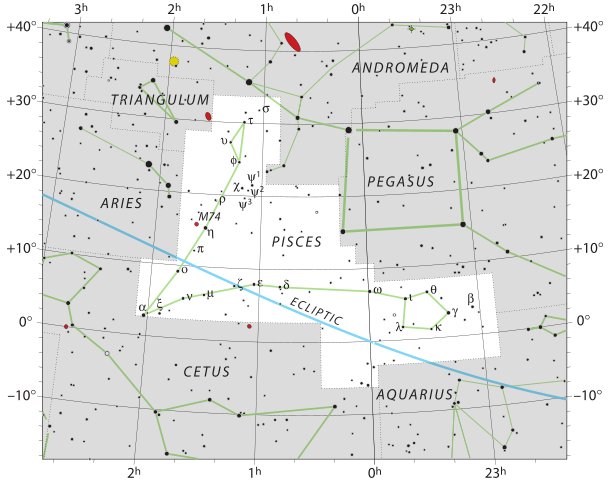2. If we continue with the number plays, then Gb7-28 can be interpreted as 28 weeks (= 196 days):
364 - 196 = 168, where 168 = 12 * 14 and 364 = 26 * 14, i.e. 196 = 14 * 14. 72 * 8 = 576 (= 16 * 36). And 72 * 2 = 144 = 576 - 432 (= 12 * 36). Thus both Gb7-22 (which also is alluding to π) and Gb7-28 appear to be significant numbers. Number 72 evidently can serve to 'bind' the stars together. Furthermore, 12 * 72 = 864 (= 364 + 500) right ascension minutes is equal to 216 days: ... Let us add 216 * 4 = 864 right ascension minutes to Achernar's 01h 36m. 864 + 96 = 960 and this is equal to exactly 16 hours, a remarkable coincidence because 16 * 29½ = 472. With equinox (in spring north of the equator and in autumn south of the equator) 96 minutes before Achenar it should be at glyph number 432 - 96 / 4 = 432 - 24 = 408 in the G text:
Alrisha is at present very close to 2h. At the beginning of the age of Pisces she (a pair of fishes indicates Moon) ought to have been at 0h. But after 2h it is time to change from Pisces to the next zodiacal sign (Aquarius). 2h / 24h = 1 / 12. The strange phenomenon of a seemingly inexplicable correlation between the present right ascension numbers and the positions of the glyphs in a text which is old perhaps is due to an effort by the creator of the text to define the end of the age of Pisces. The Maya Indians have calculated with great precision the end of one of their great eras to occur at winter solstice in this year (2012). It could be an alternative (or a complementary) explanation for the contents of the G text. The stars in Pisces are not easy to see and even Alrisha, the brightest of them, has a visual magnitude of only 4.33:
Alrisha is the last of the Pisces stars to rise. The majority of them are in the interval between 1h and 2h. With the brightest star at the end it will tend to put emphasis on the end of the era of Pisces, and the outline of the constellation clearly points at the vertex at Alrisha. The idea of 'binding the years' could possibly have been visualized in the Pisces constellation where a 'knot' at Alrisha binds together the early fish (swimming in normal fashion) with the later one (strangely rising up into the sky like the growing Moon). ... Behold what was done when the years were bound - when was reached the time when they were to draw the new fire, when now its count was accomplished. First they put out fires everywhere in the country round. And the statues, hewn in either wood or stone, kept in each man's home and regarded as gods, were all cast into the water. Also (were) these (cast away) - the pestles and the (three) hearth stones (upon which the cooking pots rested); and everywhere there was much sweeping - there was sweeping very clear. Rubbish was thrown out; none lay in any of the houses ... If my interpretation is correct, then these 3 fishes in the G text are interconnected not only by their designs but also by important star positions and by number plays. Redundance secures the reading:
In Eye in the Mud we saw how gagana in Gb7-18 possibly should be understood as a sign of how the back side was drawing to its close:
As this example shows the redundance in the G text is apparently also secured by correlations with the glyphs at the opposite side. Vaha mea in Gb7-25 (a day of Saturn) indicates its position by 72 * 5 = 360. The old year is finished and a new one is on its way. In Gb7-26 the multiplication 72 * 6 = 432 points at Gb7-21 which presumably is the location of birth. We can deduce this also from the double gills sign. The star is Achernar. But the birth is taking place north of the equator, the tails of the fishes are saying. |
||||||||||||||||||||||||||||||||||||||||||||||||||||||||||||||||||||||||||||||||||||










